The soil drawings in Peru - evidence of prehistoric aviation?
A hypothesis by August Steimann, Würzburg
In 1939, Paul Kosok from the Long Island University (New York) examined the huge soil drawings after he flew over the high arid plateau of Peru. Most of the drawings, which only can be seen from the air, were first discovered when aircraft started flying over the high desert in the 1920s. They are located between the towns of Nasca and Palpa, about 400 km south of Lima. Some are 10 km long lines, areas up to 1 km in size, and depictions of animals up to 300 meters in size. Their origin is dated between 500 BC and 1300 AD and most of them were classed as being from the Nazca civilisation. The symbols resulted by removing the ferric oxide coloured stones, revealing the dusty yellow soil.
There is no conclusive explanation for the drawings. Different hypotheses claim that the symbols have an astronomical or geological function or are places of worship, or are said to be connected with visits of beings from outer space.
A surprising hypothesis is the one of August Steimann. His hypothesis fits into the museum's understanding of aviation. Steimann visited Peru decades ago, when the soil drawings were little known.
Our thanks to Mr. Steimann for his kind permission to publish the following text in our online archives. The author placed photos and drawings at the museum's disposal as well.

The author (right) 1979, Peru. Visible soil drawings can be seen in the background.
Explanation of the Geoglyphs of Nasca as traces of prehistoric flights with kites by members of the Nazca civilisation 1,000 to 1,500 years ago
by August M. Steimann
Nasca - City in the south of Peru
Nazca - Pre-Inca civilisation of the inhabitants of the river oasis area at the Rio Grande and of the coast who were forgotten over hundreds of years
| 1500 AD | Inka |
| Chincha | |
| 1000 AD | |
| coast-Tiahuanco | |
| 500 AD | |
| Nazca | |
| 500 BC | Paracas Necropolis |
| Paracas Cavernas | |
| 1000 BC | |
| 1500 BC | early settlers |
In the area surrounding of the city of Nasca in Peru the surface of the high plateau desert like pampa was changed to show huge depiction of figures. They are called "soil drawings" or "Geoglyphs".
Most of them are straight lines, triangular or square spaces and depictions of figures. They can hardly be seen from the ground but very well by people who fly over them. The changes of the surface appear to be "Geoglyphs," clearly visible from the air.

Figures clearly visible from the air.
There are neither written records nor oral legends testifying to the meaning of the soil drawings. The geoglyphs are obviously from a pre-Inca period. Considering the style of the figures they can be assigned to the Nazca civilisation. The ground was changed about 1,000 to 1,500 years ago. Because of the lack of records testifying to their meaning there are several hypotheses. In my opinion they are not true or the given explanations are of little importance. None of the hypotheses explains the different changes of the ground in their relation to each other as indications of a function.
That is why I offer totally new hypothesis.
- 1 -
The people of the Nazca civilisation were able to fly kites that could take off and land while being tied to a rope. And they could even land without being tethered, similar to a hang glider. In spite of their Stone Age civilisation the Nasca had the technical prerequisites for the production of such kites through their manufacture of threads and fabric, known from many grave discoveries. The known two thousand years old history of manned kites in Asia also supports this possibility.
- 2 -
Depictions on pottery and textiles of the Nazca civilisation (including the Paracus findings) present in a conspicuous way gliding and falling figures. These depictions show that the people who made them were familiar with the concept of gliding and falling (even when they themselves did not belong to the "flying people").
A systematic evaluation of the depictions of findings from a "technical flight " point of view has not been done so far. Flying with kites was not assumed until now.
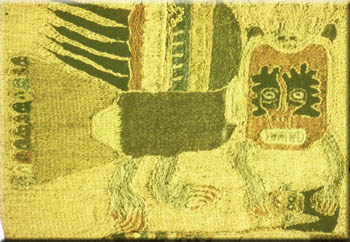
Depiction of a winged figure on textiles of the Nazca civilisation
- 3 -
The changes of the ground are the remains of a system of paths and areas that had a function for the taking off and landing and for the orientation of flying people. Thanks to the special meteorological conditions the lines close to Nasca have been quite well preserved for more than a thousand years. That is how it is possible to reconstruct the method of flying.
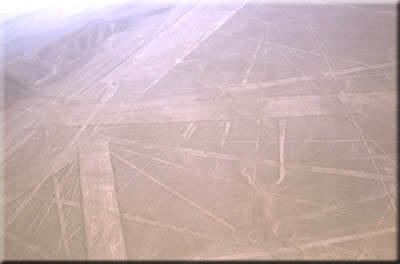
Geoglyphs in the Peruvian Pampas
- 4 -
In order to be able to fly, a kite has to be lifted by a current of air. If the current is strong enough, it is possible to lift a heavy object, with a rope tied to a kite, when at a suitable diagonal. Flying a kite is a popular game for children. If the wind is too weak, the current can be supplemented by raising the kite and running very fast against the wind.
- 5 -
The area close to Nasca was strewn with sharp-edged stones. In order to be able to run very fast against the wind, it was necessary to take away all the inconvenient stones in line with the direction of the prevailing wind. We construct runways for aircraft today for the same reason.
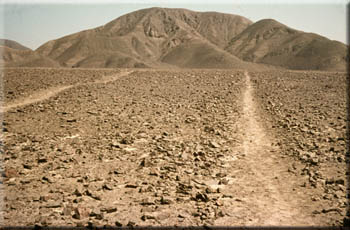
Close up of the soil drawings
In that way paths were built for the unhindered lifting up of the kites. Because of the several prevailing directions of the wind the "lines" were laid out in different directions. The troublesome stones were thrown aside.
- 6 -
Larger kites, especially kites that would lift loads, needed long, straight paths for groups of fast running people who pulled the kite rope. There are single and parallel double paths (see picture) close to Nasca. So two parallel groups of fast runners could help the kite take-off by pulling it up.
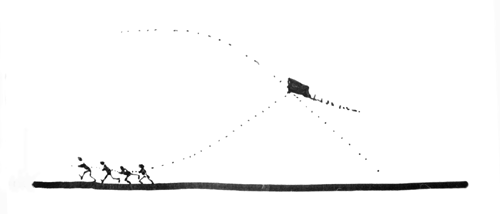
- 7 -
The strong solar radiation in the Nasca area creates vertical thermals, wind currents with a strong lifting effect. But these have their strongest effect above the weaker, horizontal ground winds. Kites that are taken above these ground winds can be lifted higher by the thermal currents than by the fast running helpers on the ground.
- 8 -
Even humans can be loaded and lifted up if the kite has a suitable size. In the 19th century, such manned kites were used by the military in Europe. During the first phase convicted prisoners could have been lifted up. As soon as some of them reached the ground alive after riding in the kite, some volunteers would have tried to fly the kites. Apart from the practical usage it is conceivable that the technique was used for ceremonial and religious rituals or for demonstration of power.
- 9 -
 A landing of the tethered kite can be implemented by pulling in the rope. In the area of the weaker ground winds it is dangerous for the people or a load to be attached to the kite, because it is possible that unexpected movements of the flying machine can lead to damage. This can be prevented by people who assemble for the landing. But for this purpose they needed more space than the width of the paths. At Nasca the ends of many paths were cleared of the stones and widened into larger areas, a reason explaining why the paths end in triangles or trapeziums.
A landing of the tethered kite can be implemented by pulling in the rope. In the area of the weaker ground winds it is dangerous for the people or a load to be attached to the kite, because it is possible that unexpected movements of the flying machine can lead to damage. This can be prevented by people who assemble for the landing. But for this purpose they needed more space than the width of the paths. At Nasca the ends of many paths were cleared of the stones and widened into larger areas, a reason explaining why the paths end in triangles or trapeziums.
- 10 -
In addition to the triangular and trapezium widening of the paths, there are huge square areas close to Nasca. The huge areas are suitable for practising taking off and landing of kites in different wind directions. They allow greater movements in several directions. So the cleared areas might have served among other purposes as "practise areas."
- 11 -
People who learn how to fly a tethered kite and become familiar with the unusual state of flight - compelled or voluntary - will learn through experience that their body movements will affect the flight.
The modern hang glider is steered by changing the position of the centre of gravity through a stiff trapezium like steering system used by the person hanging below the glider. In the course of the flights with tethered kites during the Nazca period, people hanging below the kite could have developed the skill to change the attitude of the airfoil in the wind. This turns a kite into a hang glider that only has to be freed from the ropes in order to become a controlled, free flying kite. The development of the hang glider forty years ago occurred exactly this way.
Strong slope (ridge) and thermal updrafts are able to reduce or even to overcome the rate of descent, so that the kite is able to rise. The strong solar radiation in the desert at Nasca produces very strong thermal updrafts. The turning of a tethered kite into a free flying, steerable hang glider could have been possible with the technical skills of the Nazca civilisation.
- 12 -
During a free flight in strong updrafts, winds can carry the aircraft far from the paths and landing helpers. That is why landmarks are necessary in order to find quickly the way back to the accompanying ground group. Such orientation above the gray brown desert with no natural landmarks is hardly possible. But the needed landmarks can be easily made by the same method that was used for the building of the paths - by taking away the top soil and stones. Because the landmarks need to be clearly distinguishable from the straight paths and areas and need to be easily seen, depictions of figures are obvious choices.
Close to Nasca depictions of animals, plants, helixes and other symbols were created. When newly made they can be seen clearly from the air.
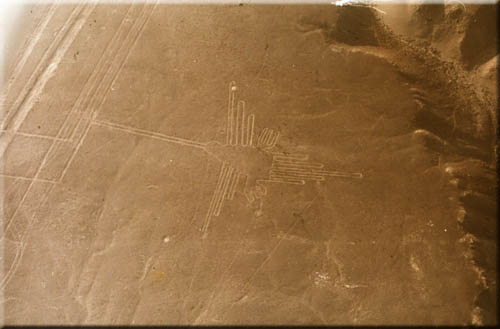
The "humming bird," length: about 100 meters
These authentic soil drawings or Geoglyphs follow drawings by the Nazca in their stylistic form. They do not have a primary artistic or aesthetic function but were clearly identifiable landmarks. These symbols probably indicate that the people in Nasca were not only able to fly while tethered, but also in free flight.
The only way this could have been possible, considering the developments in technology in the Nazca civilisation, was through the technique of the modern hang glider, meaning changing the center of gravity of the airfoil above a person hanging below.
- 13 -
Assuming a more simple explanation, the depiction of figures also could have a heraldic function or mark the launching areas. Their visibility from the air could have been the ritual destination of a manned flight. It is obvious that the early art of flight would also serve the prevailing religion because a "raising" of "privileged" people fits well into ritual demonstrations of power.
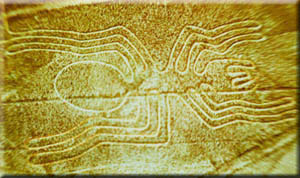
The "spider," length about 60 meters
- 14 -
With the discovery and assessment of archeological findings of the Nazca and other American civilisations the possibility of humans flying should be taken into consideration, in order to understand archeological findings, which, until now, no consideration was given.
The primitive kites were presumably made of light wooden frames that were held together by ropes and covered with fabric. The materials might have been given as burial objects to the dead and crash victims. The ceramics and textiles should be more closely examined in order to find hints of possible early flight techniques, because the Nazca civilisation depicted many gliding figures.
In the collections of American Indian stories, many figures appear able to fly. More study should be done of this.
- 15 -
However important the evidence of flying at Nasca is, it should not be taken as the only evidence of "early flying." At the moment these lines can be regarded as the best preserved signs. The unique climatic conditions prevent a covering over or other destruction of the drawings. Other signs at other places should be examined for evidence of "early flying."
The surroundings of today's Nasca could have been a flight learning centre, because there are so many lines. The different depictions of figures could indicate several competitive groups of flying people.
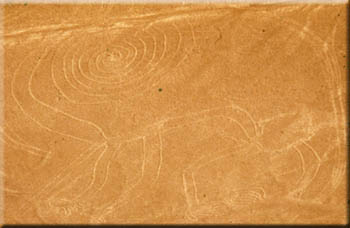
The "monkey," length about 100 meters
- 16 -
The reason why the Nasca flying ability was lost, can be that the privileged, to whom the active pilots surely belonged, were killed in tribal wars or refused to pass on their knowledge after being subjugated. If victorious enemies tried to copy the style of the conquered, most attempts must have had a deadly ending, because the flying devices, constructed under the technical circumstances of the Nasca surely were very fragile.
Also, sufficient experience is necessary for control of a flying machine. The privileged pilots certainly had an interest in limiting the number of people able to fly.
In the future, if the possibility of early flying is taken into consideration when artifacts are discovered and evaluated, more information about flying devices and techniques used under primitive conditions may be gained.
Special examination should be made of the American Indian flying legends. Heinrich Schliemann discovered the lost City of Troy by study of an up-to-then "unbelievable legend."
